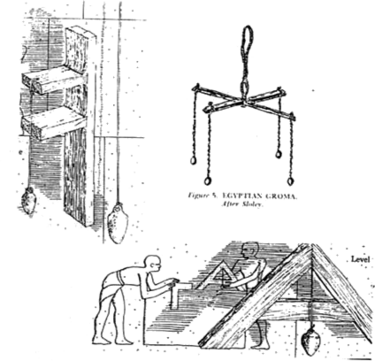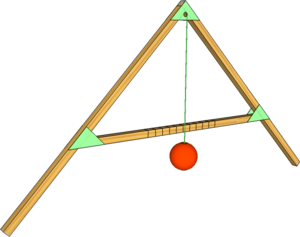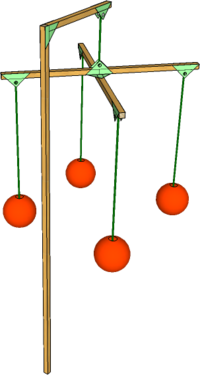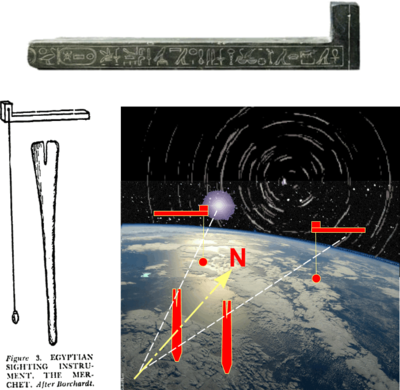Ancient Egyptian Survey Tools: Difference between revisions
From DT Online
(Added Merkhet) |
No edit summary |
||
| (24 intermediate revisions by the same user not shown) | |||
| Line 1: | Line 1: | ||
[[File:Egyptian.png|right| | [[File:Egyptian.png|right|375px|]] | ||
__TOC__ | __TOC__ | ||
=====Introduction===== | =====Introduction===== | ||
Egypt is regarded as the home of the first known [ | Egypt is regarded as the home of the first known [http://en.wikipedia.org/wiki/Surveying '''Surveyors''']. Surveying was necessary in '''[[:Category:Ancient Egypt|Ancient Egypt]]''' because the annual floods buried or destroyed boundary markers, which then had to be re-established for ownership of the fields. | ||
Using only basic equipment the Pyramids were built and aligned with astonishing accuracy. The [ | Using only basic equipment the Pyramids were built and aligned with astonishing accuracy. The [http://en.wikipedia.org/wiki/Great_Pyramid_of_Giza '''Great Pyramid at Giza ''(Khufu)'''''] has been measured at 231 meters square and the largest discrepancy is 30cm between the north and west sides - but the difference between the north and east sides is only 6cm! | ||
[[File:Plummet.png|right|100px]] | [[File:Plummet.png|right|100px]] | ||
=====Plummet===== | =====Plummet===== | ||
At its simplest, a [ | At its simplest, a [http://en.wikipedia.org/wiki/Plumb_bob '''Plummet'''] ''(aka [http://en.wikipedia.org/wiki/Plumb_bob '''Plumb Bob'''])'' is a small weight suspended on a cord and is still much in use today. | ||
A more elaborate type of ''Plumb Bob''' was found in the tomb of the architect [ | A more elaborate type of '''Plumb Bob''' was found in the tomb of the architect [http://en.wikipedia.org/wiki/Sennedjem '''Senedjem'''] at Deir el-Medina. The board was held vertically against the wall to be tested and the '''Plumb Bob''' was attached to a wooden crossboard so that the cord, if in a vertical position, would touch a second cross board below, which was the same size as the first. | ||
Once a vertical is established then horizontals can also be set by placing a '''[[Squares|Builders' Square]]''' against it. '''Plumb Bobs''' were used also to establish a vertical [ | Once a vertical is established then horizontals can also be set by placing a '''[[Squares|Builders' Square]]''' against it. '''Plumb Bobs''' were used also to establish a vertical [http://en.wikipedia.org/wiki/Datum_reference '''Datum Reference'''] in other surveying instruments. | ||
[[File:SquareLevel.png|right|300px]] | [[File:SquareLevel.png|right|300px]] | ||
=====Square Level===== | =====Square Level===== | ||
The '''Square Level''' was the main levelling instrument used not only in Ancient Egypt but also in later Roman and | The '''Square Level''' was the main levelling instrument used not only in '''[[:Category:Ancient Egypt|Ancient Egypt]]''' but also in later '''[[:Category:The Romans|Roman]]''' and '''[[:Category:Middle Ages|Medieval]]''' building although water-filled trenches may have been used to level larger distances. Smaller versions of '''Water Levels''' were developed much later. They were known to the '''[[:Category:The Romans|Romans]]''' but used by them for only special purposes. | ||
Ancient | '''[[:Category:Ancient Egypt|Ancient Egypt]]''' versions had two legs of equal length, connected at a right angles and with a cross piece to create a tool in the shape of the letter 'A'. From the connecting corner of the two legs was suspended a '''Plumb Bob''', which could line up with a mark in the centre of the cross piece when the two legs were stood on the horizontal surface of a building stone for example. | ||
[[File:Groma.png|right|200px]] | [[File:Groma.png|right|200px]] | ||
=====Groma===== | =====Groma===== | ||
| Line 34: | Line 33: | ||
The long vertical pole was set vertically in the ground at the start corner and turned until one of the cross-pieces lined up with one of the sides of the field to be set out. Sightings were then made along the second cross piece and a [ | The long vertical pole was set vertically in the ground at the start corner and turned until one of the cross-pieces lined up with one of the sides of the field to be set out. Sightings were then made along the second cross piece and a [http://en.wikipedia.org/wiki/Ranging_rod '''Ranging Pole'''], some distance from the '''Groma''', aligned and set into the ground to mark a line at right angles to the first side. | ||
Later, the Romans made great use of the [ | Later, the '''[[:Category:The Romans|Romans]]''' made great use of the [http://en.wikipedia.org/wiki/Groma_surveying '''Groma'''] to set out the centre of military camps and new towns from which they then created the regular grids on which they based their town planning ''(i.e. [http://en.wikipedia.org/wiki/Cardo cardo] and [http://en.wikipedia.org/wiki/Decumanus_Maximus decumanus] grids)''. | ||
---- | |||
<span style="color: blue">'''Activity:''' | |||
Make some model '''[[:Category:Ancient Egypt|Ancient Egypt]]''' survey tools and survey your own room - or house. What are the dimensions in '''Cubits'''? Is everything vertical or horizontal? What is the area of your garden in '''Setats'''? | |||
</span> | |||
---- | |||
=====Merkhet===== | =====Merkhet===== | ||
[[File:UsingMerkhet.png|right|400px]] | [[File:UsingMerkhet.png|right|400px]] | ||
[ | [http://en.wikipedia.org/wiki/History_of_timekeeping_devices_in_Egypt '''Measurement of time'''], especially of the seasons, was extremely important to the '''[[:Category:Ancient Egypt|Ancient Egypt]]''' since they needed to know when to sow their crops and when the [http://en.wikipedia.org/wiki/Flooding_of_the_Nile '''Nile would flood'''] each year. | ||
They used [http://en.wikipedia.org/wiki/Sundial '''Sundials'''] ''(perhaps they noticed that the moving shadows from their ceremonial [http://en.wikipedia.org/wiki/Obelisk '''Obelisks'''] created a kind of '''[[Ancient Egyptian Sundials|Sundial]]''' but it is not thought they were used as such until erected by the '''[[:Category:The Romans|Romans]]''' much later)'', they constructed [http://en.wikipedia.org/wiki/Egyptian_calendar '''Calendars'''] and used their skill with [http://en.wikipedia.org/wiki/Egyptian_astronomy '''Astronomy'''] to determine dates of religious festivals and the hours of the night. | |||
[http://en.wikipedia.org/wiki/List_of_Egyptian_pyramids '''Egyptian Pyramids'''] were very accurately aligned North, South, East, West and it was their knowledge of [http://en.wikipedia.org/wiki/Egyptian_astronomy '''Astronomy'''] which made this possible. Egyptian architects, surveyors and builders are known to have used two specialised surveying tools: the [http://en.wikipedia.org/wiki/Merkhet '''Merkhet'''] ''(the 'instrument of knowing', similar uses to an [http://en.wikipedia.org/wiki/Astrolabe '''Astrolabe'''])'' and the '''Bay''' ''(a sighting tool probably made from the central rib of a palm leaf)''. | |||
They will have observed that, when looking at the night sky to the North, stars appeared to precess in a circle around the North Pole ''(a consequence of the Earth's rotation)''. Text and illustrations of the time suggest that the [http://en.wikipedia.org/wiki/Merkhet '''Merkhet'''] was used to mark where a particular star would sink below the horizon and then reappear later ''(in much the same way as our nearest star, the Sun, sets and rises each day - a good candidate for such a star at that time would have been [http://en.wikipedia.org/wiki/Vega Vega] although [http://en.wikipedia.org/wiki/Beta_Ursae_Minoris b-Ursae Minoris] and [http://en.wikipedia.org/wiki/Ursa_Major#Other_stars z-Ursae Majoris] have also been put forward)''. One person would have stood at an observation point and sighted the falling ''(or rising)'' star through a narrow slit in a palm leaf, known as a '''Bay'''. A second person could move until a '''Plum Bob''' suspended from a [http://en.wikipedia.org/wiki/Merkhet '''Merkhet'''] crossed the line of sight and then mark a point on the ground. This process would be repeated to create an angle between where a star rises and where it falls. Bisecting this angle would always give a true North ''(nowadays we may look at [http://en.wikipedia.org/wiki/Polaris '''Polaris'''] as our [http://en.wikipedia.org/wiki/Pole_star '''North Star'''] but at the time of the '''[[:Category:Ancient Egypt|Egyptians]]''' it was not where it is today because the Earth ‘wobbles’ over time - a phenomenon known as [http://en.wikipedia.org/wiki/Nutation '''Nutation'''])''. | |||
[[File:Hatshepsut and Seshat.jpg|right|200px|Hatshepsut and Seshat|link=http://en.wikipedia.org/wiki/Seshat#/media/File:Hatshepsut_and_Seshat.jpg]] | |||
[http://en.wikipedia.org/wiki/Rope_stretcher '''Stretching of Cords'''] to determine the proper astronomical orientation of a temple was regarded as a sacred ritual in which the '''[[:Category:Ancient Egypt|Egyptians]]''' relied on divine guidance. The [https://en.wikipedia.org/wiki/Pharaoh '''Pharoah'''] was believed to be assisted by a goddess called [http://en.wikipedia.org/wiki/Seshat '''Seshet'''] ''(the goddess of wisdom, knowledge, writing, the calendar and also architecture, astronomy, astrology, building, mathematics, and surveying)''. | |||
[ | Illustrations of the ceremony are on the wall of a temple in [http://en.wikipedia.org/wiki/Abydos,_Egypt '''Abydos'''] and the [http://en.wikipedia.org/wiki/Chapelle_Rouge'''Red Chapel of Hatshepsut''']. On the walls of the temple of [http://en.wikipedia.org/wiki/Temple_of_Edfu '''Horus in Edfu'''] are recorded words of the [https://en.wikipedia.org/wiki/Pharaoh '''Pharoah'''] as follows: | ||
<div class="center">''I take the peg-pole, I grasp the club by its handle, I stretch the cord with Sesheta. I turn my sight to follow the stars' movements, I fix my gaze on the astrality of Msihettu. The star-God that announces the time reaches the angle of its [http://en.wikipedia.org/wiki/Merkhet '''Merkhet''']; I establish the four corners of the God's temple.''</div> | |||
---- | |||
<span style="color: green">'''Note:''' | |||
'''DT Online''' notes that there seems little point in having the upturned end of the [http://en.wikipedia.org/wiki/Merkhet '''Merkhet'''] simply to suspend a '''Plum Bob'''. Was the [http://en.wikipedia.org/wiki/Merkhet '''Merkhet'''] perhaps a combination instrument able to sight stars at night and serve as a hand-held '''[[Ancient Egyptian Sundials|Sundial]]''' during the day? | |||
</span> | |||
---- | |||
{{Stripwood Frames Buyers Guide}} | {{Stripwood Frames Buyers Guide}} | ||
| Line 58: | Line 77: | ||
[[Category:Primary]] | [[Category:Primary]] | ||
[[Category:Topics, Projects and Tasks]] | |||
[[Category:Tasks]] | |||
[[Category:Measuring and Surveying]] | |||
[[Category:Ancient Egypt]] | [[Category:Ancient Egypt]] | ||
[[Category:The Romans]] | |||
Latest revision as of 18:22, 10 March 2021
Introduction
Egypt is regarded as the home of the first known Surveyors. Surveying was necessary in Ancient Egypt because the annual floods buried or destroyed boundary markers, which then had to be re-established for ownership of the fields.
Using only basic equipment the Pyramids were built and aligned with astonishing accuracy. The Great Pyramid at Giza (Khufu) has been measured at 231 meters square and the largest discrepancy is 30cm between the north and west sides - but the difference between the north and east sides is only 6cm!
Plummet
At its simplest, a Plummet (aka Plumb Bob) is a small weight suspended on a cord and is still much in use today.
A more elaborate type of Plumb Bob was found in the tomb of the architect Senedjem at Deir el-Medina. The board was held vertically against the wall to be tested and the Plumb Bob was attached to a wooden crossboard so that the cord, if in a vertical position, would touch a second cross board below, which was the same size as the first.
Once a vertical is established then horizontals can also be set by placing a Builders' Square against it. Plumb Bobs were used also to establish a vertical Datum Reference in other surveying instruments.
Square Level
The Square Level was the main levelling instrument used not only in Ancient Egypt but also in later Roman and Medieval building although water-filled trenches may have been used to level larger distances. Smaller versions of Water Levels were developed much later. They were known to the Romans but used by them for only special purposes.
Ancient Egypt versions had two legs of equal length, connected at a right angles and with a cross piece to create a tool in the shape of the letter 'A'. From the connecting corner of the two legs was suspended a Plumb Bob, which could line up with a mark in the centre of the cross piece when the two legs were stood on the horizontal surface of a building stone for example.
Groma
The Groma was a right-angle device designed for laying out the corners of fields, much like the Surveyors' Cross of more recent times.
The long vertical pole was set vertically in the ground at the start corner and turned until one of the cross-pieces lined up with one of the sides of the field to be set out. Sightings were then made along the second cross piece and a Ranging Pole, some distance from the Groma, aligned and set into the ground to mark a line at right angles to the first side.
Later, the Romans made great use of the Groma to set out the centre of military camps and new towns from which they then created the regular grids on which they based their town planning (i.e. cardo and decumanus grids).
Activity: Make some model Ancient Egypt survey tools and survey your own room - or house. What are the dimensions in Cubits? Is everything vertical or horizontal? What is the area of your garden in Setats?
Merkhet
Measurement of time, especially of the seasons, was extremely important to the Ancient Egypt since they needed to know when to sow their crops and when the Nile would flood each year.
They used Sundials (perhaps they noticed that the moving shadows from their ceremonial Obelisks created a kind of Sundial but it is not thought they were used as such until erected by the Romans much later), they constructed Calendars and used their skill with Astronomy to determine dates of religious festivals and the hours of the night.
Egyptian Pyramids were very accurately aligned North, South, East, West and it was their knowledge of Astronomy which made this possible. Egyptian architects, surveyors and builders are known to have used two specialised surveying tools: the Merkhet (the 'instrument of knowing', similar uses to an Astrolabe) and the Bay (a sighting tool probably made from the central rib of a palm leaf).
They will have observed that, when looking at the night sky to the North, stars appeared to precess in a circle around the North Pole (a consequence of the Earth's rotation). Text and illustrations of the time suggest that the Merkhet was used to mark where a particular star would sink below the horizon and then reappear later (in much the same way as our nearest star, the Sun, sets and rises each day - a good candidate for such a star at that time would have been Vega although b-Ursae Minoris and z-Ursae Majoris have also been put forward). One person would have stood at an observation point and sighted the falling (or rising) star through a narrow slit in a palm leaf, known as a Bay. A second person could move until a Plum Bob suspended from a Merkhet crossed the line of sight and then mark a point on the ground. This process would be repeated to create an angle between where a star rises and where it falls. Bisecting this angle would always give a true North (nowadays we may look at Polaris as our North Star but at the time of the Egyptians it was not where it is today because the Earth ‘wobbles’ over time - a phenomenon known as Nutation).
Stretching of Cords to determine the proper astronomical orientation of a temple was regarded as a sacred ritual in which the Egyptians relied on divine guidance. The Pharoah was believed to be assisted by a goddess called Seshet (the goddess of wisdom, knowledge, writing, the calendar and also architecture, astronomy, astrology, building, mathematics, and surveying).
Illustrations of the ceremony are on the wall of a temple in Abydos and the Red Chapel of Hatshepsut. On the walls of the temple of Horus in Edfu are recorded words of the Pharoah as follows:
Note: DT Online notes that there seems little point in having the upturned end of the Merkhet simply to suspend a Plum Bob. Was the Merkhet perhaps a combination instrument able to sight stars at night and serve as a hand-held Sundial during the day?
- Structures and Frames can also be modelled using the Construction Kits listed in the Truss Bridges and Looking at Bridges articles.
Safety Point! Take great care with hot glue guns and all hot-melt glues. The melted glue can stick to the skin and cause severe burns.
 |
 |
 |
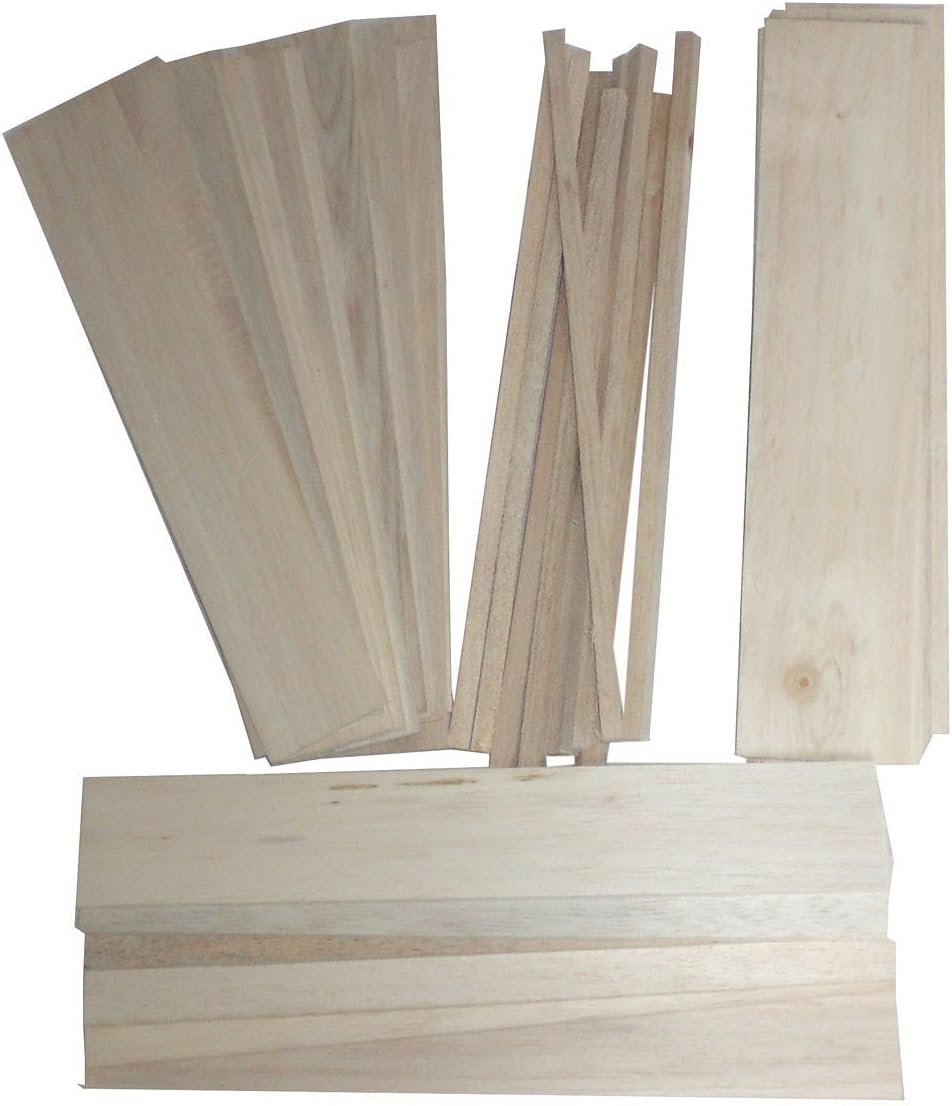 |
 |
 |
 |
 |
 |
 |
 |
| Junior Hacksaw |
Clamp-on Hobby Vice |
Stripwood |
Balsa Wood |
Medium card coloured |
Thick card coloured |
Cutting Mat |
10mm Squared Paper |
PVA glue |
Glue Gun |
Bamboo Flower Sticks |
Notes:
- Choose metal cutting hacksaw blades - the teeth are small which suits this scale of work and they are safer for young children
- School PVA glue is best for young children because it is non-toxic and washes off : PVA Wood Glue is strongest but must be used with care.
- Try to get natural Flower Sticks or wear gloves because the green stain comes off on hands!
